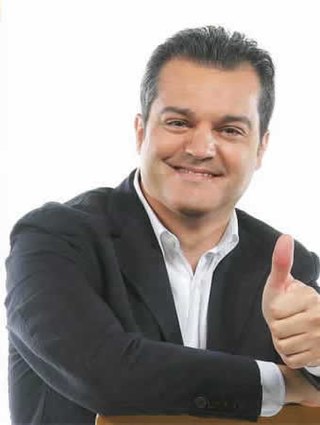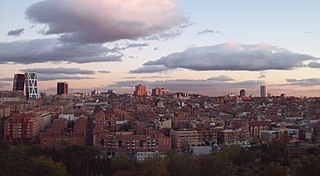
In the Gregorian calendar, New Year's Eve, also known as Old Year's Day, is the evening or the entire day of the last day of the year, 31 December. In many countries, New Year's Eve is celebrated with dancing, eating, drinking, and watching or lighting fireworks. Some Christians attend a watchnight service. The celebrations generally go on past midnight into New Year's Day, 1 January.

The Puerta del Sol is a public square in Madrid, one of the best known and busiest places in the city. This is the centre of the radial network of Spanish roads. The square also contains the famous clock whose bells mark the traditional eating of the Twelve Grapes and the beginning of a new year. The New Year's celebration has been broadcast live since 31 December 1962 on major radio and television networks including Atresmedia and RTVE.

Concepción Velasco Varona, known professionally as Concha Velasco, also Conchita Velasco, was a Spanish actress, singer, dancer, television presenter, and theatrical producer. She received numerous accolades throughout her career in film, theater, and television spanning over six decades, including two National Theater Awards presented by the Spanish Ministry of Culture in 1972 and 2016, the Lifetime Achievement Award presented by the Spanish Television Academy in 2009, and the Honorary Goya Award presented by the Spanish Film Academy in 2012.

María del Carmen García Galisteo, known professionally as Carmen Sevilla, was a Spanish actress, singer, and dancer. She began her career in the 1940s and became one of the most popular and highest paid stars of Spanish cinema until the 1970s. In 1991, at the age of sixty, she began her career as a television presenter, working for the three major Spanish networks until her retirement in 2010. At the time of her death, she was one of the last surviving stars from the Golden Age of Mexican cinema and from the Golden Age of Hollywood.

Ramón García Hernando is a Spanish radio and television presenter. He is also colloquially known as Ramontxu or Ramonchu. His long professional career and his versatility have been demonstrated in television shows like ¿Qué apostamos? and El Grand Prix del verano, and in nineteen live broadcasts of the New Year's Eve clock bell strikes.

Tetuán is a district of Madrid, Spain.

Usun Yoon is a South Korean TV host, actress, and reporter based in Spain.
Janette Becerra is a Puerto Rican poet, writer, teacher and literary critic. She obtained an MA in comparative literature and a Ph.D. in Spanish literature at the University of Puerto Rico, Río Piedras Campus. She has been a professor of Hispanic Studies at the University of Puerto Rico at Cayey since 2000.
Martes y Trece were a trio of Spanish comedians whose members were Josema Yuste, Millán Salcedo and Fernando Conde. Their style was characterized by grotesque gags on everyday life and caricatures of famous people. The trio made their first television appearance in 1978 on a program by José María Íñigo, and due to their success they repeated four times. Fernando Conde left the group in 1985 to dedicate himself to the theater, but Josema Yuste and Millán Salcedo continued to act together until 1997.

Cristina Pedroche Navas is a Spanish presenter, TV reporter and model.
This is a list of Spanish television related events from 1961.

Jordi Sánchez Zaragoza is a Spanish actor and screenwriter, mostly known for his role as Antonio Recio in La que se avecina and Josep Lopes in Plats bruts. He got a Certificate of Advanced Study on nursing at the Universidad Autónoma de Barcelona.

Vanesa Romero Torres is a Spanish actress and model, mostly known for her roles as Ana in Aquí no hay quien viva and Raquel in La que se avecina.

The Royal House of the Post Office is an eighteenth century building in Puerta del Sol, Madrid. It was built for the postal service, but currently serves as the office of the President of the Community of Madrid, the head of the regional government of the Autonomous Community of Madrid. This should not be confused with the City Council of Madrid, which is housed in another former post office, the Cybele Palace.

Roberto José Leal Guillén is a Spanish television presenter, reporter and journalist.

Ana Alicia Guerra Morales, better known as Ana Guerra, is a Spanish singer and musical actress. She rose to prominence when she took part in series nine of the reality television talent competition Operación Triunfo, where she finished in fifth place.
This is a list of Spanish television related events from 1962.

Lara Álvarez González is a Spanish journalist and television presenter.

The history of the Puerta del Sol represents an essential part of the memory of the Villa de Madrid, not only because the Puerta del Sol is a point of frequent passage, but also because it constitutes the "center of gravity" of Madrid's urban planning. The square has been acquiring its character as a place of historical importance from its uncertain beginnings as a wide and impersonal street in the sixteenth century, to the descriptions of the first romantic travelers, the receptions of kings, popular rebellions, demonstrations, etc. It has been the scene of major events in the life of the city, from the struggle against the French invaders in 1808 to the proclamation of the Second Republic in 1931, and it has also retained its place as the protagonist of the custom of serving twelve grapes on New Year's Eve, to the sound of the chimes struck by the Correos clock. Nowadays it is a communications hub, a meeting point, a place of appointments, a place for celebrations and the beginning of demonstrations in the Capital.

Sandra Daviú Ripoll is a Spanish journalist and television presenter.

















